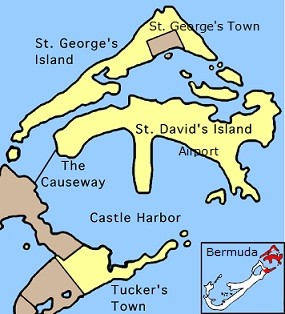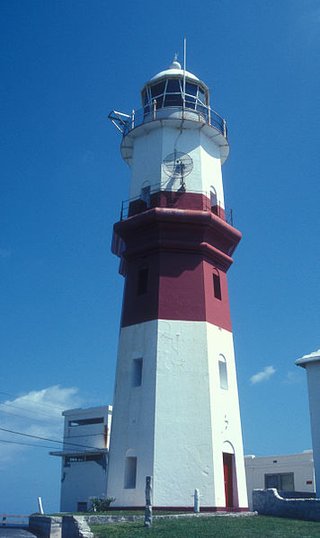St Davids Bermuda
St David's is one of the two large islands that comprises the
St. George's Parish of Bermuda. The other one being the St. George's Island. Covering an area of 650 acres, St. Davids is the eastern most part of Bermuda and had been long isolated.
It was eventually joined to the main island of Bermuda in 1877 when the British Royal Engineers built the
Causeway that connected the two ends. The island was named after Saint David, the patron saint of Wales. There are two water areas between St David's Island and St George's island.
As you can see in the map below, there is a large water body towards the north-eastern side with several tiny islands in it. This is the
St George's Harbor. A channel called 'Town Cut' located between St. George's mainland and Higgs and Horseshoe islands is used by the cruise ships since 1920s to enter the harbor from the open Atlantic. Earlier a channel called 'Narrows' was used.
Road Map (St. David's)
There is another thin strip of water channel that runs between the two islands towards the south western side and connects the St. George Harbor with the
Castle Harbor. This three mile long narrow strip of water channel is called
Ferry Reach. In the south east of St Davids, there is a small and seemingly isolated island - The
Cooper's Island.
The original residents of St. Davids were a diverse mix of immigrants who started coming in from 17th century. There were a large number of native American Indians who came as slaves and lived here. There were also indentured (i.e. debt bonded) laborers who came from England, and blacks from West Indies and other places. Being isolated from the main island, St. Davids once used to be the home for the lower class poor people.
But during the second world war, the peace and the harmony of the closely knit community at the St Davids was seriously impacted when U.S. military started to set up its base here in 1941. They took up more than half of St Davids including the Coopers Island. The area was successively used by US Army, US Airforce, and then for US Naval Air Station. After 54 years, the US Military finally left the island in 1995, and people from all over Bermuda started to pour in to build up their homes here.
Although today the population of St Davids is a similar mix of immigrants as rest of Bermuda, many here still boast of deep connections with native Americans. There is a biannual St Davids Island Indian Festival held here that are participated by native Americans from Naragansett, Wampanoag, Mashantucket Pequots, Cherokee and other tribes.
St. David's Attractions
An 1879 lighthouse that was built with Bermuda lime stones to serve as a guiding beacon for the passing ships. It is still operational although the original kerosene lamp with a wick was replaced by a petroleum burner in 1922.
St. David's Lighthouse
Source: Wikimedia Commons
This lovely beach is located in Coopers Island at Annie's Bay. It was opened to public only in 1995 when the US Military left the island. Over the years many facilities have been added including a beach house, an eatery, picnic places, children playground, skating rink and even nature trails. Clearwater is one of the favorite family picnic beaches for the locals. Other great beaches in the area are Turtle Beach, Well Bay, Long Bay and Fort Hill Bay beaches.
Clearwater Beach Imagery
Rotate the image for 360° view
Located next to the Clearwater Beach, this is a 12-acre serene parkland with many pepper and all-spice trees along with patches of cedars and palmettos. The nature trail and the boardwalk take you through a salt marsh and plantations that are home to many kinds of birds.
This house was built in the mid or late 1600s by the descendants of a man who stayed back in Bermuda in 1610 while George Somers and others sailed for Virginia. Made of stone, this is one of the oldest historical houses in Bermuda showcasing original vernacular architecture.
The fort is located at Great Head Park of St. Davids Head at the eastern edge of the island. Built in early 1900s, this fort was commissioned to protect the Narrows Channel through which the ships enter the St George's Harbor.
Once you cross the causeway that connects the main island of Bermuda to St. Davids, you will be on Kindley Field Road that leads to the airport.
Located south of St Davids in Castle Harbor, this small island replicates what Bermuda used to be originally centuries back. There are many endemic plants like cedars, casuarinas, olivewood and palms. It is also home to Bermuda's
National Bird Petrel that once became almost extinct and also for longtails. The island has tiny virgin beaches, fresh water marsh and densely wooded areas. It is now a nature reserve and a sanctuary.
Transports to St David's
There is only one bus route #6 serving St. Davids. It starts from St George's Town, goes up to St David's and returns. There is a bus every 1 hour during the day time. All the buses take the St Davids Main Road and go up to Southside Gate-1, while few of them also serve Clearwater Beach. The bus takes 25 minutes to reach the Clear Water Beach and goes past St. David's Lighthouse. Although the bus service is available all 7 days a week, there is no direct bus to Clearwater beach on Sundays.
You can also get ample taxis at St. George's Town (Kings Square) to get to St. David's. However a
rented scooter or an electric
mini car would be an ideal transport for tourists.
|
 By Raj Bhattacharya By Raj Bhattacharya
Raj, a seasoned travel writer and Bermuda destination expert, has extensive global travel experience. This website reflects his profound insights, garnered over nearly two decades of dedicated findings and research on the island. Raj has assisted countless Bermuda-bound visitors by providing direct, personalized responses to their queries and imparting his wealth of knowledge through this platform. This site serves as an indispensable guide for those seeking informed and reliable insights into Bermuda's treasures.
|
Related Articles
1) Check out
St. George's Parish to know about the parish where St Davids and the town of St. George are located and all its attractions and activities.


 By Raj Bhattacharya
By Raj Bhattacharya